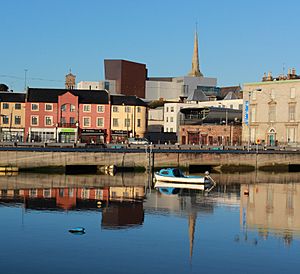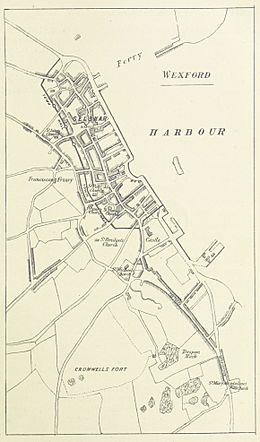Sack of Wexford facts for kids
Quick facts for kids Siege of Wexford |
|||||||
|---|---|---|---|---|---|---|---|
| Part of the Cromwellian conquest of Ireland | |||||||
 Wexford waterfront |
|||||||
|
|||||||
| Belligerents | |||||||
| Commanders and leaders | |||||||
| Strength | |||||||
| 3,500 - 4,000 | c. 6,000 | ||||||
| Casualties and losses | |||||||
| 1,500 - 2,000 killed (including civilians) 3,000 captured |
c. 20 killed Unknown wounded, or died of disease |
||||||
The Sack of Wexford happened from October 2 to October 11, 1649. It was a major event during the Cromwellian conquest of Ireland. This conquest was part of the wider Irish Confederate Wars (1641–1653). Forces from the Commonwealth of England, led by Oliver Cromwell, attacked the town of Wexford. They stormed the town after talks failed. Most of the soldiers from the Irish Confederate and Royalist sides were killed. Many regular people also died, some during the attack, and others by drowning while trying to escape.
Contents
Why the Attack Happened
In 1649, Ireland was a very complicated place. The Catholic Confederation and the Royalists (who supported the king) had joined forces. This happened after King Charles I was executed in England. They wanted to keep the monarchy.
However, a powerful Irish Catholic leader, Eoghan Ó Néill, did not join this alliance. Instead, he made a separate agreement with the English Commonwealth forces. This weakened the Royalist and Confederate side.
The Royalist leader, the Duke of Ormond, tried to capture Dublin. But his army was defeated at the Battle of Rathmines. This victory allowed Oliver Cromwell and about 12,000 experienced English soldiers to land safely near Dublin.
Ormond's plan was to avoid big battles. Instead, he wanted to hold important port towns along the east coast. He hoped that by delaying Cromwell's army, hunger and sickness would weaken them as winter arrived.
Cromwell's Powerful Army
However, Ormond's plan did not account for Cromwell's powerful new cannons. These guns were too strong for the old walls of towns like Drogheda. Drogheda was attacked on September 3, and its walls were quickly broken. When the defenders refused to surrender, the town was stormed. Many of the 2,600 soldiers there were killed. This event was a harsh warning from Cromwell.
After Drogheda, Cromwell went back to Dublin. Ormond went to Kilkenny, the Confederate capital. Cromwell then moved his main army towards Wexford. Wexford was an important port. It was used by Irish ships, called privateers, to attack English merchant ships. It also connected Ireland to the exiled Royalist court in France.
Cromwell's army moved very fast. This was because their supplies and cannons were carried by ships. These ships were led by Richard Deane. Ormond sent 1,000 men to defend Wexford, led by David Synnot. Cromwell's army, about 6,000 strong, arrived outside Wexford on October 2. Two days later, Cromwell's men captured nearby Rosslare. This gave Deane's ships a safe place to land.
The Siege of Wexford

When Cromwell arrived, he offered the Wexford defenders a deal. They could leave without their weapons, and the town would not be harmed. The town's leaders liked this offer. But David Synnot, the military commander, refused. He wanted to delay Cromwell, just as Ormond had planned. It was raining, and many of Cromwell's soldiers were getting sick.
While waiting for his cannons to arrive by ship, Cromwell kept talking with Synnot. On October 5, Synnot received 1,500 more soldiers. Ormond had planned to help Wexford himself. But he had to go to Youghal because its Royalist soldiers changed sides. Still, Ormond sent Synnot another 600 men. These were led by Colonel Edward Butler.
The Attack Begins
On October 11, Cromwell's cannons began firing. They focused on the castle, which was defended by Captain Nicholas Stafford. Synnot then agreed to Cromwell's first offer. But when his representatives met Cromwell, they made new demands. They wanted religious freedom. They also wanted the soldiers to keep their weapons. And they wanted the privateer ships in the harbor to leave with their goods. Cromwell thought these demands were too much and became impatient.
The cannons broke through the castle walls in two places. Captain Stafford surrendered when Cromwell's soldiers started getting ready to attack. Stafford did not tell Synnot and Butler about his surrender. This surprised them. Commonwealth troops from the castle then broke into the town.
The Sack of the Town
What followed was a terrible event known as the "sack." Between 1,500 and 2,000 soldiers and regular people died. Over 300 of them drowned trying to escape across the river. About 3,000 more were captured. Cromwell's army lost only about 20 soldiers.
In his report, Cromwell said this was payback for Protestants killed earlier in the rebellion. He also said he was sad that the damage meant he couldn't use Wexford for his army's winter camp. Some historians, like Tom Reilly and Nicholas Canny, believe Cromwell might not have ordered the full attack. They think his soldiers might have started plundering without his direct command.
What Happened Next
The loss of Wexford was a big blow for the Royalist side. It meant that King Charles II could not land in Ireland. The Royalist fleet, led by Prince Rupert, left Kinsale and sailed to Lisbon. The port of Wexford could no longer be used by privateers. The English Parliamentarians claimed they captured over 80 privateer ships and 100 fishing boats.
Ormond's army was greatly weakened. Many of his soldiers had been sent to Wexford and were then killed or captured. He had fewer than 3,000 men left. Cromwell then captured New Ross. He tried to attack Waterford, but he had to stop because his soldiers were getting sick and running out of supplies. Between October and November, over 1,000 of Cromwell's soldiers died from disease.
Despite these challenges, Cromwell's campaign in 1649 was very successful. It seriously weakened the alliance between the Royalists and the Confederates. This alliance was already fragile because the groups had different goals. Many Protestant Royalists in Cork changed sides. Then Lord Inchiquin and the rest of Munster followed. By mid-December, Cromwell's forces controlled almost all of Ulster.

